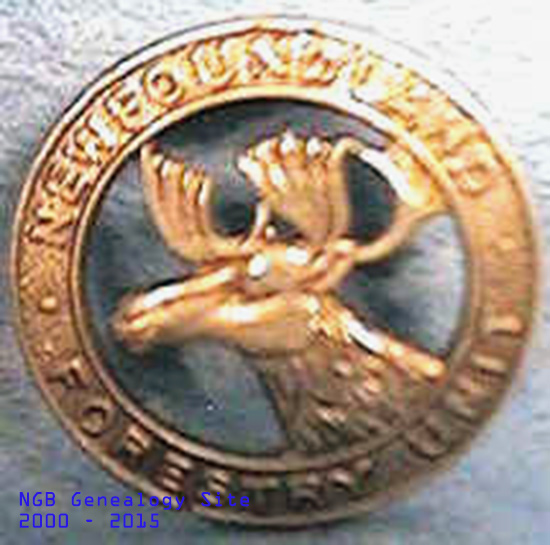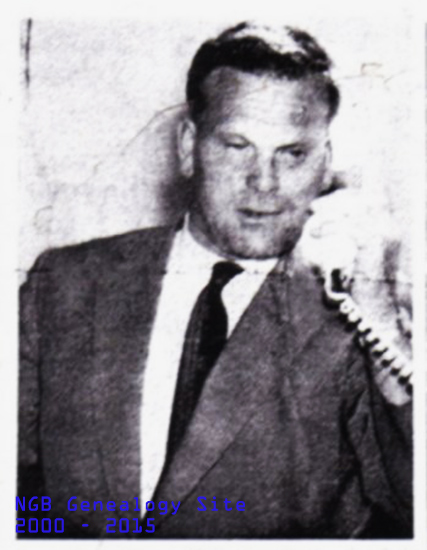Presented by the
Newfoundland's Grand Banks Site
to assist you in researching your Family History
Click on the graphic below to return to the NGB Home Page
To contribute to this site, see above menu item "About".
These transcriptions may contain human errors.
As always, confirm these, as you would any other source material.
 Newfoundland
Overseas Forestry Unit
Newfoundland
Overseas Forestry Unit

|
The photo and the article were taken from the
Evening Telegram newspaper
By DOUG MARSHALLCirca 1963-1964 Donated by Tom Caines A fortune in muckNewfoundlander, fourth richest Canadian in Britain CARDIFF, Wales. Larry Ryan, as all south Wales knows, is "that Canadian lumberjack who made a million out of muck". Back in 1947, the burly 49 year old Newfoundlander surveyed the dreary tips or slag heaps that turned Glamorganshire's green valleys grey and decided they contained a fortune in coal. Welshmen have been kicking themselves ever since. Today, Ryan figures he is worth "something between $12 and 15 million dollars". That makes him the fourth richest Canadian in Britain after the "trio of tycoons" - baker Garfield Weston and publishers Roy Thompson and Lord Beaverbrook. Ryan is no boardroom tycoon. Clad in an old windbreaker and rubber boots [everybody's private image of a true backwoodsman] he spends 8-10 hours a day in the field keeping a foreman's eye on operations and often driving bulldozers himself. "I don't want anyone to take the shovel away from me", he says. "I like work and I know about coal and I want it to go on that way". Hired managers tend the executive side of the diversified business which now includes contracting and road haulage and the boss himself is never in the office more than a few hours a week. Ryan is a down-to-earth, blunt-talking member of the new rich. But this costs him no loss of respect in an area where none of the old rich are left, and ordinary miners see nothing unusual in forming a hunt and riding to the hounds In fact, his alchemistic success in turning dross to gold has fired the imagination of this tough industrial hinterland where expansion has been hindered by memories of the Depression and 50 % unemployment. The Welsh, who revere poets and rugby players, see Ryan as a sort of champion quarterback of industry or a Dylan Thomas of the tip heaps. But their admiration is tinged with chagrin. Everybody knew there was good coal mixed with the abandoned slag. Most adults can remember scrabbling for it in the cold 1930s for enough fuel to keep family hearths warm. Birth of an idea Yet it took Ryan, an inexperienced foreigner, to perceive that the coal could be extracted on a commercial scale and sold at a high profit for burning in modern steam-powered electrical generating plants. Few men can point to a moment in time and say "That is where it all began". Ryan believes it was the knowledge of rivers gained during his early logging experience that gave him the key to his extraction process. He was born in Port Saunders, a village north of Corner Brook, and began lumber-jacking at 15. He came to Britain in 1940 with the Newfoundland Forestry Corps and settled down after the war in Cardiff with his Welsh wife. His interest in coal began when he began shoveling coal sludge from river banks into barges. On his first day out he loaded 70 tons in 15 hours, working stripped to the waist in a December wind. "I remember looking up once and seeing my undershirt froze to the side of the barge. I had an advantage over my rivals. I was in peak condition and could throw a shovelful farther than anyone else". Ryan soon realized that the natural process by which coal sludge filtered up through the river mud could be reproduced artificially. He sold the idea to a bank, raised some capital and had 30 years' supply of apparently worthless slag tied up before anybody knew what had happened. He now has leases on or owns freehold most of the major slag heaps in south Wales. His biggest cup came early last year when he purchased a lease on a tip heap for 10,000 pounds. "The fellow was asking 30,000 pounds but I waved the cheque under his nose and he soon gave in. I figure there is 10 million pounds worth of coal in that tip and after any costs and overhead have been covered I'll have a clear profit of 4 million pounds. Ryan deals directly with the Central Electricity Generating Board, by-passing the National Coal Board, and his delivered price of 65 shillings a ton is 10 shillings cheaper than the NBC's product. With nuclear power stations still a long way in the future as an economic proposition, Ryan sees nothing but expansion ahead. Business circles agree with him. When L. Ryan holdings Ltd. opened for business on the Cardiff stock market the shilling ordinary shares closed on the first day at more than 4 shillings Although still a Canadian citizen [his father was born in Ottawa], Ryan has no plans for returning to Canada. Eventually he hopes one of his five sons will take over the business. He also has two daughters. The family lives in a redecorated mock-Tudor mansion on the hills behind Cardiff. Ryan is essentially a family man who entertains rarely and would rather talk about teething problems than politics. He plays an occasional round of golf with a close business friend but is shy when mixing with his financial peers. His two material luxuries are a maroon Rolls-Royce, which he drives himself, and a 60 foot launch moored on the nearby British Channel |
Return to the Main Military Records Index
Military Records Contact: Sherwin Flight
Newfoundland's Grand Banks is a non-profit endeavor.
No part of this project may be reproduced in any form
for any purpose other than personal use.
JavaScript DHTML Menu Powered by Milonic
© Newfoundland's Grand Banks (1999-2025)
Hosted by
![]()
Your Community, Online!
![[Recent]](../../recent.gif)
![[Home]](../../home.gif)